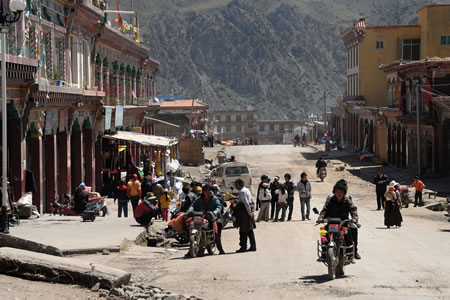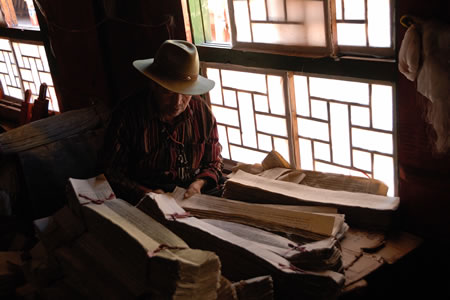English | Dutch |
|
| China’s southwest | |
Hong Kong (China) to Xīníng (China), May 2010 |
|
After four great weeks of travelling together with Edwin’s parents in the Philippines and Hong Kong, we are back on China’s mainland. This time, we have the plan to travel through China’s south-western part that lies next to Tibet. From the city of Guàngzhōu, we took a domestic flight to Dálĭ City, to start our tour through the provinces of Yúnnán, Sìchuān and Qīnghăi. Dálĭ lies in the province of Yúnnán, which was an important destination for the hippie-backpackers in the past. Present day Dálĭ still reminds you on those times. The main street with bars and restaurants is still called “Foreigner street” and certain eateries advertise “magic mushrooms” explicitly, for those travellers who want a complete hippie-experience including the narcotics. However, foreign tourists are completely outnumbered by the domestic tourists. The Chinese mass tourism has taken off massively and millions of Chinese tourists are visiting cities like Dálĭ, Lijāng and Shangri-La in this ever more popular province. The backpackers of the past came here to chill out for some days or weeks, because of the relaxed atmosphere in this town in the hilly countryside. The growth in domestic tourism with tour guides who scream through their microphones has taken its toll on the atmosphere. Also the costs of a visit to Dálĭ have risen dramatically. When you like to walk to a temple on the mountain, you have to pay an entrance fee for the mountain as well as for the temple. In the past, the lake nearby could always been crossed by a public boat. Nowadays, even the lake has an admission fee and tourists have to charter an expensive tourist boat to cross it. In de end, we only spent one day in this city. The hikes that we had planned to walk were simply not worth the money. In the more remote places in China, the scenery is at least as beautiful but there you can enjoy it for free. Still, our day in Dálĭ was nice. Especially the town market was very colourful and worth a visit. So, even when a touristy town is a little bit disappointing the Chinese life in general always has some nice surprises on offer. Because we were a bit disappointed by Dálĭ, we skipped Lijāng on our itinerary and went directly to Shangri-La. This city is a perfect example of Chinese opportunism. “Shangri-La” is for many visitors an almost magical name, because a place with this name had a prominent role in James Hilton’s book “Lost Horizon”. The city Zhōngdiàn noticed the appeal that the name Shangri-La had on many readers. With dollar signs in their eyes, they changed the city-name from one day on the other to “Shangri-La”. This has been a perfect move. The tour busses that go to Lijāng, now also go to Shangri-La. After we turned around at the ticket office of the most important monastery (see also the column: The price tag of development), we tried to buy a bus ticket to Déqīn. The mountain scenery surrounding this town is said to be spectacular. Unfortunately, we weren’t lucky. The road to Déqīn is being improved and the Chinese don’t like doing things the slow way. Therefore, the road is closed for ten days in a row and after being open for one day it is closed for ten days again. |
|
 |
|
Tibetan wildwest scene in the little town of Manigango |
|
| For us, the first days in the south-western part of China were certainly disappointing. We got the feeling that, in the end, we would have travelled through this region without really enjoying it. Fortunately, our worries would prove to be needless. After Shangri-La, we left the typical tourist trail to go to Xiāngchéng. This small town in the province of Sìchuān, took our worries away instantly. After meeting the friendly people and spending great hours in the town’s monastery (see photo-impression: Xiāngchéng - a great monastery) we knew that southwest China is certainly worth a visit. On forehand, we thought that Yúnnán would be the most interesting province, but in the end Sìchuān won our heart. Via the mainly Tibetan town of Lĭtáng (see also the photo-impression: Lĭtáng - Tibetan atmosphere in China) we travelled to our favourite spot in this part of China so far: Gānzī. The city is in itself not very special, but its people are warm and friendly. In the middle of the city is a small monastery that is used intensively. On a small square in front of it, you can observe the everyday live of the Tibetans that live here. People are walking in traditional clothes, the women have their hair in long braids and the prayer wheels that people are carrying are rotated constantly. The main monastery is on a hill next to the city. Here we received a warm welcome by the monks and we were even invited to observe the dinner session of the monks. While praying they got their evening meal and as soon as everybody had their food, the only thing that you could hear was hundreds of monks smacking and eating with their chopsticks. Also Gānzī’s surroundings are great to explore. Snowy peaks dominate the landscape and while exploring the area you always walk into the friendly people and small monasteries where monks or nuns always treat you on a warm welcome. (see also the photo-impression: Gānzī - an unpolished pearl in Sìchuān)
Dégé is the next place on our route. There were only two seats left on the bus to the town, and those seats are on the back bench. Due to the bumpy road, we flied several times at least a metre from our seats when the driver went through a large hole on full speed. On the way, we passed the Tro-La pass of approximately 5000 metres. The route that we travel through southwest China is constantly between 3000 and 4000 metres in altitude. Walking uphill costs extra energy because of the lower oxygen levels in the air on this height, but if you take it easy during the first days it isn’t really a problem. The road to Dégé is one of the nicest roads that we travelled in China so far. The mountain peaks are covered with snow and some are more than 6000 metres high. The views are superb. Our fellow bus passengers are all Chinese, and they are not very interested in the views. They prefer to take care of their stomach, so they eat all day. Chicken feet are the most popular snack along the way. The toenails of the chicken are the only part of the feet that they don’t eat and those are being spitted on the ground. In the end, this is still China! | |
 |
|
Tibetan printed material is being counted and bound together in
the monastery of Dégé |
|
In Dégé, we visited the Printing Press Monastery. This is one of the three most important Tibetan Monasteries together with two that are in the “true” Tibet. In this monastery in Dégé, they have 70% of the Tibetan literary heritage and visitors can see how the printing process is still done in the traditional way. The monastery is beautiful, but the larger influx of tourists has made the city itself less friendly than a place like Gānzī. We decided to stay only one full day, after which we went to Manigango. The yaks dominate the surrounding countryside of the village together with the vultures that eat the carcasses of these immense animals if they die. At approximately 12 kilometres outside the town, lies the picturesque Yihun Lhatso. Our visit to this lake was nice, but it could have been much better if the weather was a bit more cooperative. When the sunlight hits the water of the lake, it turns the water into a spectacular turquoise-blue colour. The day we visited the lake, unfortunately, it didn’t stop raining. During the eight hour walk, we weren’t able to take off our rain poncho. After Manigango we went via the small town of Sêrxu (a true open-air museum) to Yùshù in the province of Qīnghăi. Yùshù is struck by a strong earthquake on last April 14th and the sight of this devastated city will probably stay with us for ever. Because we aren’t “disaster tourists”, we left this city and the surrounding sights the same day. (see also the article: An exciting day). When people are still dependent on emergency relief efforts, this isn’t to place to go to as a tourist. The sleeper bus from Yùshù to Xīníng is dominated by cigarette smoke and loud Chinese music, but in the end the night bus (which we normally resent) wasn’t as bad as we anticipated on forehand. We arrived at 4 a.m. in Xīníng where we foun a nice youth hostel. We took a nice room with private bathroom. This is something different than the accommodation of the last days. We really looked forward to room like this, with the luxury of hot water and a clean toilet that we don’t have to share with other people. We will stay for some days in Xīníng, before we go by train to Beijing. Several contributions to the website have to uploaded, so we can use these extra days before we go to China’s capital. It is always a good sign when we can make a lot of contributions for the site, as this is an indication that we have seen and experienced a lot. Seeing and experiencing things are the main reasons to travel and south-western China is a perfect area for that cause. In Beijing, we are going to prepare ourselves for our trip to Mongolia. Again, a completely different country than the other countries on our trip so far; we can’t wait!
|
|
| <Previous weblog> | |